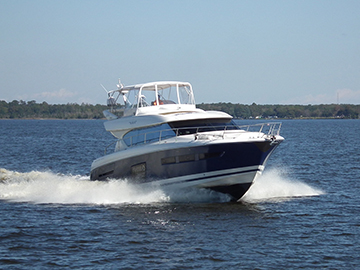 |
| Likely suspects for different parts of your boat Main Cabin: Engine noise through the deck, floor and carpet Engine noise through the bulkheads Engine noise transmitted through your vents Structural engine noise causing vibrations throughout the space Noise from your generator Noise from your AC Aft Deck: Engine noise through the deck, floor and carpet Engine noise through the bulkheads Structural engine noise causing vibrations throughout the space Exhaust noise Propeller noise Waves slapping against the hull Sleeping spaces: Engine noise through the deck, floor and carpet Engine noise through the bulkheads Structural engine noise causing vibrations throughout the space Noise from your generator Noise from your AC Noise from other cabins What to do about these sources of noise |
Cruisers
Over the past 30 years, Soundown has built up extensive experience in reducing noise aboard cruisers. We’ve used that experience to develop this list of recommendations for dealing with the most common noise sources. While no two boats are the same, this list will get you on course towards a quieter vessel and a more enjoyable boating experience.
Each treatment description below includes recommended materials as well as the path it will treat (airborne and/or structure borne).
Treatment: Engine room insulation
Path: Airborne
Source: Engine
Improved areas: cabins, helm deck
Problem: The size of most cruisers means most of your time aboard is spent in close proximity to the engines and generators. Whether on deck or inside, you are typically separated from the engine by only a single bulkhead or deck. As a result, a significant portion of the noise is airborne.
Solutions:
Reducing noise levels on board will require increasing the noise blocking ability (known as transmission loss) of the bulkhead or deck and sealing any penetration spots where noise can leak out. Here are a few ways to accomplish that.
- Barrier composite insulation on the overhead and bulkheads. Barrier composites sandwich a layer of mass-loaded vinyl with acoustic foam. The foam absorbs noise while the mass-loaded layer reflects noise back into the engine room, protecting accommodation areas. Soundown’s IVF (insulated vinyl/foam) composite sheets are highly effective aboard most vessels and are easy to install in new builds or during refit. Thicker is generally better if you have the space.
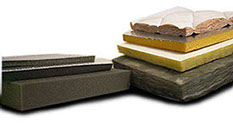
Best bet: 2” 2lb for diesel engines, 2” 1lb for gas engines
- EcoDamp is a flexible, self adhesive damping sheet that can be easily formed to seal bulkhead and deck penetrations. Identifying and sealing all possible leaks is an essential step in reducing noise on your boat.
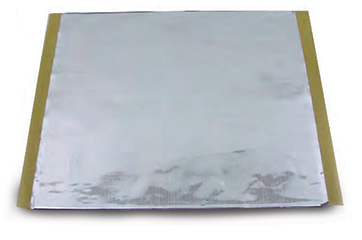 One technique for finding these gaps is to climb into the engine compartment, close the hatch and look for areas where you can see daylight (or a light source placed in the adjoining space, for interior bulkheads). Any place where light can come through, noise can also leak out.
One technique for finding these gaps is to climb into the engine compartment, close the hatch and look for areas where you can see daylight (or a light source placed in the adjoining space, for interior bulkheads). Any place where light can come through, noise can also leak out.
Typically, you’ll find this leakage around plumbing and wiring. Eco Damp sheets are an excellent and flexible solution for this type of leakage. They feature an aluminum soft cover and are largely composed of self-adhesive rubber, which allows them to be shaped and molded to fill gaps and create barriers that can be removed later as needed.
Best bet: EcoDamp
- Gaskets around hatches are critical in reducing leakage which allows machine room noise to invade other spaces. Make sure that when each hatch is closed, the seals are tight. You inspect a hatch’s seal by inserting a business card. If you can get it into the seam, the Gasket isn’t tight enough.
Where possible, you want the gasket on the hatch itself – it will take a lot less wear and tear there. It’s also best to get D-profile or finger-top style rubber gaskets. These seal well across a wider variety of gaps than solid gaskets. it’s rare that the gap between deck and hatch is consistent all the way around, so the best gaskets are flexible enough to handle irregularities. - For vessels with fuel tanks outboard of the engines we recommend Soundown’s IAF acoustic foams. IAF does not feature a barrier – the foam absorbs reverberant noise in the machinery space resulting in lower levels of noise transmitted throughout the boat.
Best bet: 1”
- For a high level of finish and additional noise reduction, Soundown QuieTech perforated aluminum sheets can be installed over the insulation.
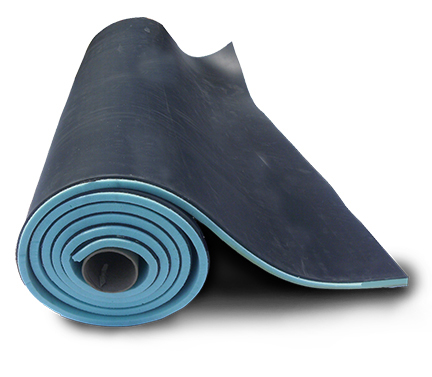
Treatment: Interior soles
Path: Airborne & structure-borne
Improved areas: cabins
Problem: Structure-borne noise radiates through the soles, producing noise and often vibrations you can feel in your legs. Treatments that go above the deck are particularly effective against these vibrations.
Solutions:
- Soundown premium carpet underlayment, an alternative to standard carpet padding, provides plush foam padding that decouples a denser mass layer from the deck. The sole, carpet underlayment and carpet work together to create layers of sound absorption and blocking. Carpet Underlayment comes in a variety of thicknesses to accommodate your headroom requirements. While thickness constraints mean carpet underlayment is not a replacement for good engine room insulation, it can be a good upgrade to boats with well insulated engine rooms or a quick, easy first step for boats where engine room insulation isn’t enough.The ease of installation makes this treatment an easy upgrade for any vessel.
Best bet: ½” 2lb Premium Carpet Underlayment
Treatment: Engine room noise leaking through bulkheads
Path: Airborne & structure-borne
Improved areas: Cabin forward of engine room
Problem: Depending on the proximity of the cabin to the engines, good engine room insulation may not be enough. This culprit is typically the high level of structure-borne vibration in the bulkhead which radiates into the cabin.
Solutions:
- Gaskets around the bulkheads are also a great solution to leaking engine room noise (see machinery space above).
Best bet: Neoprene Gaskets
- Isolating or “floating” the interior panel. By floating the interior panel, we can break the path of that vibrational energy, reducing interior noise.
- The detail below shows a floated bulkhead.
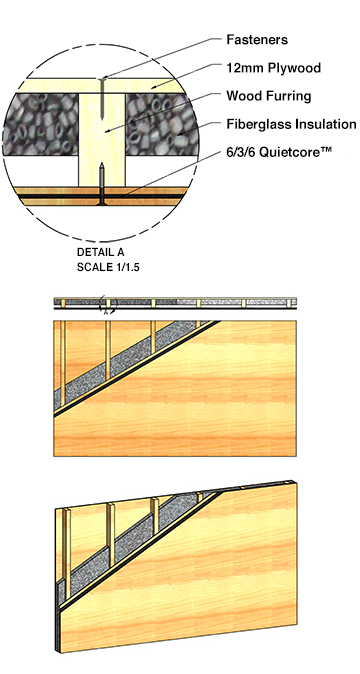
Engine vibration transmitted through the hull
Path: Structure-borne
Improved area: All areas
Problem: The lightweight construction typical of cruisers, combined with the high horsepower of their engines, means significant vibration can be created while the engine does its job. Smaller cruisers don’t really lend themselves to Isolation mounts, but larger cruisers may have room in the engine compartments.
Solutions:
- Isolation Mounts for the engine. These decouple the engine from the hull, isolating a significant portion of the vibration. While there are many options that can be considered, space constraints usually mean that engine and gear boxes are close coupled and require a mount that can handle the force of the propeller thrust. The Rubber Design TT mounts (thrust & torque) are designed specifically for such applications. The TT’s unique design uses a series of rubber plates in shear, to provide isolation when positively or negatively loaded. By combining size and rubber stiffness options, Soundown can select a mount that avoids excessive engine movement while providing ideal vibrational isolation.
See also:
Generator noise
– on larger sailboats, this can be a bigger concern than engine noise.
Air conditioning noise
– in warmer climates, this can be a constant noise source for larger boats.
